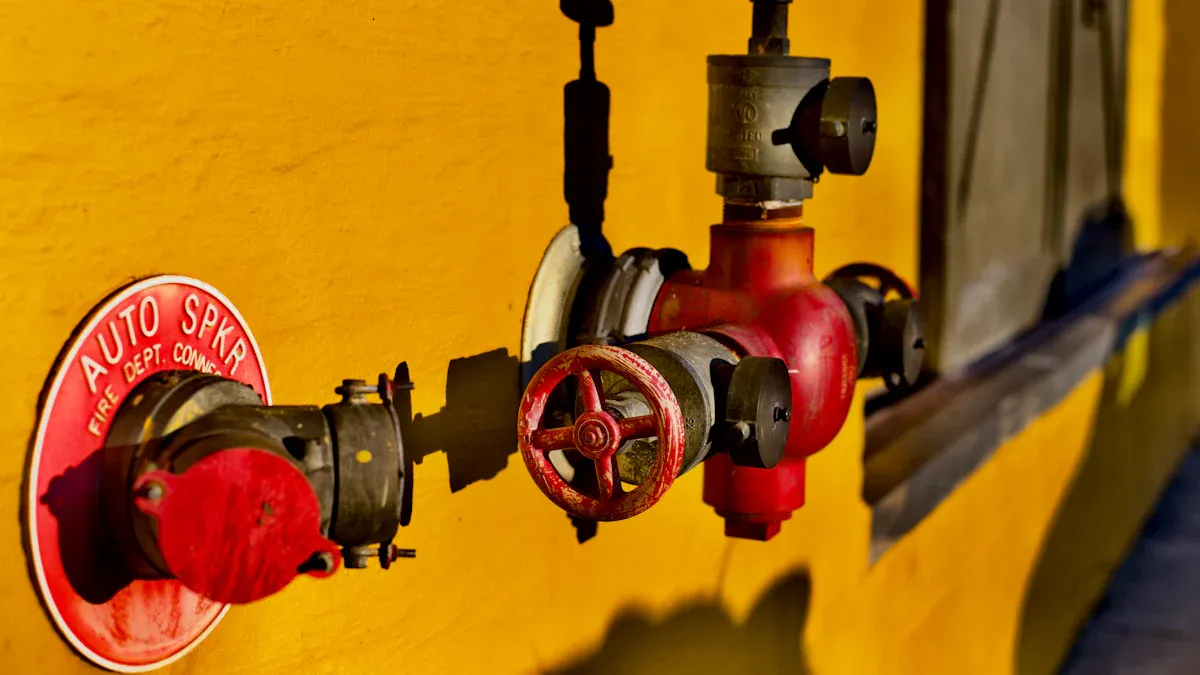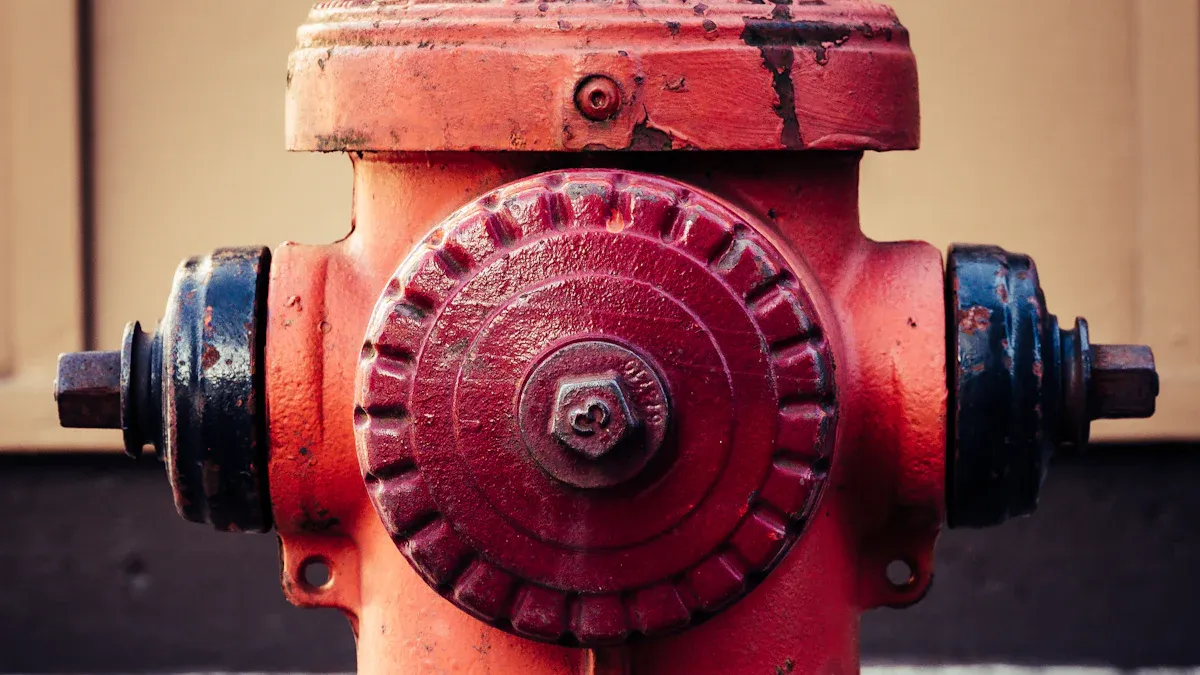
Fire Hydrant Valves play a vital role in ensuring public safety and effective fire protection. Regular maintenance of the Fire hydrant valve, guided by NFPA 291 standards, guarantees its optimal performance during emergencies. Neglecting these essential components, such as the Hydrant Valve International Outlet Fitting, can lead to severe consequences, including reduced water pressure or system failure. Proper care of the Fire Hydrant Valve ensures reliability and compliance with safety regulations.
Key Takeaways
- Regular checks and water flow tests are very important for fire hydrant valves. Check them every year and test water flow every five years to meet NFPA 291 rules.
- Taking care of hydrants, like adding grease and checking them in different seasons, stops rust and keeps them working well. This helps hydrants last longer and keeps people safe.
- Keeping good records is important to track maintenance work. Write down checks, fixes, and test results to follow rules and make sure hydrants work in emergencies.
NFPA 291 Compliance for Fire Hydrant Valves
Overview of NFPA 291 and its purpose.
The NFPA 291 Standard serves as a critical guideline for fire and water departments. It establishes best practices for testing water flow and marking fire hydrants. By adhering to this standard, departments ensure that hydrants remain accessible and functional during emergencies, ultimately enhancing public safety. The standard also categorizes hydrants based on their flow rates, which helps firefighters quickly assess water availability.
| Hydrant Color | Flow Rate Classification | Flow Rate (gpm) |
|---|---|---|
| Red | Class C | Less than 500 |
| Orange | Class B | Up to 1,000 |
| Green | Class A | Up to 1,500 |
| Light Blue | Class AA | 1,500 and more |
These classifications simplify the identification of hydrant capabilities, ensuring efficient firefighting operations.
Key compliance requirements for fire hydrant valves.
NFPA 291 mandates specific testing and inspection protocols to maintain the performance of fire hydrant valves. Flow tests must be conducted every five years to verify that hydrants can deliver adequate water under varying conditions. Additionally, the standard outlines two types of flow tests: one evaluates the water supply in the main, while the other assesses the flow through the hydrant itself. These tests ensure that fire hydrant valves meet the necessary flow rates and pressures required for effective firefighting.
Importance of regular inspections and flow testing.
Regular inspections and flow testing are essential for maintaining the reliability of fire hydrant valves. Annual inspections verify the operational status of hydrants, address any necessary repairs, and confirm their reliability. Flow tests, conducted every five years, determine the available water in the system at 20 psi residual pressure. This information is crucial for ensuring that hydrants can support fire suppression efforts effectively. Neglecting these practices can compromise public safety and lead to non-compliance with NFPA 291 standards.
Step-by-Step Maintenance Process for Fire Hydrant Valves

Inspection of Fire Hydrant Valves
Components to inspect: valve caps, stems, seals, and bolts.
Inspecting fire hydrant valves begins with a thorough examination of critical components. Valve caps should be checked for tightness and signs of wear. Stems must be inspected for smooth operation and alignment. Seals require attention to ensure they are intact and free from cracks or deterioration. Bolts should be examined for corrosion or looseness, as these can compromise the structural integrity of the valve.
Identifying signs of wear, corrosion, or damage.
Signs of wear, corrosion, or damage include rust on metal parts, cracks in seals, and difficulty turning the valve stem. Discoloration or pitting on the surface may indicate corrosion. Any visible leaks or dripping water around the valve suggest seal failure. Regular inspections help identify these issues early, preventing costly repairs and ensuring the reliability of fire hydrant valves.
Testing Fire Hydrant Valves
Conducting flow and pressure tests.
Flow and pressure tests validate the operational performance of fire hydrant valves. These tests measure the water supply’s capacity and pressure to ensure compliance with NFPA 291 standards.
- Select a group of hydrants in the same vicinity and inspect each for damage.
- Attach a pressure gauge to the static/residual hydrant and open the valve to stabilize the pressure reading.
- Use a pitot gauge to measure velocity pressure from the flow hydrant(s) while simultaneously recording residual pressure.
The flow rate (Q) can be calculated using the formula Q = 29.84cd²√p, where ‘c’ is the coefficient of discharge, ‘d’ is the outlet diameter in inches, and ‘p’ is the pitot pressure in psi. This calculation ensures hydrants meet the required flow rates for firefighting operations.
Tools required: pressure gauges, flow meters, and lubricants.
Essential tools for testing include pressure gauges to measure static and residual pressure, flow meters to calculate water flow rates, and lubricants to ensure smooth valve operation. These tools facilitate accurate testing and maintenance, ensuring compliance with NFPA 291.
Steps to ensure compliance with NFPA 291.
To comply with NFPA 291, conduct flow tests every five years and inspect hydrants annually. Document all test results and maintenance activities. Address any issues promptly, such as leaks or low pressure, to maintain operational readiness.
Troubleshooting Common Issues
Addressing leaks, stuck valves, and low water pressure.
Leaks often result from damaged seals or loose bolts. Replace seals and tighten bolts to resolve the issue. Stuck valves may require lubrication or cleaning to remove debris. Low water pressure can stem from blockages in the hydrant or water main. Clearing obstructions and conducting flow tests can restore proper pressure levels.
When to repair versus replace components.
Repair components when issues are minor, such as replacing seals or lubricating stems. Replace parts if damage is extensive or if repairs fail to restore functionality. For example, corroded bolts or severely damaged stems may require replacement to ensure the valve operates effectively.
Seasonal Maintenance for Fire Hydrant Valves
Winter preparation to prevent freezing.
Winter maintenance focuses on preventing freezing, which can damage fire hydrant valves. Drain faucets to remove residual water, insulate exposed parts, and apply antifreeze solutions. Inspect caps and valves for tightness and remove snow or ice around the hydrant to ensure accessibility.
Summer care for optimal performance.
Summer maintenance involves inspecting for leaks, corrosion, and vegetation growth around hydrants. Lubricate moving parts to ensure smooth operation. Perform flow tests to verify water supply capacity and repaint hydrants to protect against environmental wear.
Importance of seasonal checks.
Seasonal checks ensure fire hydrant valves remain functional year-round. Winter preparation prevents freezing-related damage, while summer care addresses wear and tear from heat and humidity. Regular seasonal maintenance enhances reliability and extends the lifespan of hydrants.
Addressing Common Issues with Fire Hydrant Valves

Causes and solutions for leaking or dripping valves
Leaking or dripping fire hydrant valves often result from aging infrastructure, damaged seals, or loose bolts. Studies, such as those conducted by Utah State University and the EPA, highlight the role of aging infrastructure in increasing water main breaks and leaks. The following table summarizes key findings:
| Study/Source | Findings | Key Insights |
|---|---|---|
| Utah State University | Water main breaks increased by 27% over six years | Aging infrastructure is a significant cause of leaks; smaller utilities face higher break rates. |
| AWWA Studies | Aging infrastructure remains a concern; inadequate replacement rates | Proactive management of water systems is essential to prevent leaks. |
| EPA Study (2002) | Only 0.8% of installed pipes are replaced annually | Highlights the growing number of pipes needing immediate replacement. |
| Kelly Olson’s Insights | Digital leak detection is crucial for effective management | Technology aids in identifying and documenting leaks for future analysis. |
To address leaks, technicians should inspect seals for cracks or wear and replace them if necessary. Tightening bolts can resolve minor issues, while more severe cases may require replacing damaged components. Proactive maintenance, including regular inspections, can prevent leaks and extend the lifespan of fire hydrant valves.
Preventing and treating corrosion and rust
Corrosion and rust are common issues that compromise the functionality of fire hydrant valves. Exposure to moisture, oxygen, and environmental pollutants accelerates the corrosion process. Preventative measures include applying anti-corrosion coatings and using rust-resistant materials during manufacturing. Regular cleaning and inspections also help identify early signs of rust.
When treating existing corrosion, technicians can use wire brushes or sandblasting to remove rust. Applying a rust inhibitor or primer afterward protects the valve from further damage. For severe cases, replacing corroded parts may be necessary. Consistent maintenance ensures the valves remain operational and compliant with NFPA 291 standards.
Fixing stuck or hard-to-turn valves
Stuck or hard-to-turn fire hydrant valves often result from inadequate lubrication, bent stems, or corrosion in the main valve. The following steps can help resolve these issues:
- Add oil through the oil fill plug to ensure proper lubrication.
- Inspect the stem for bending caused by over-tightening. Replace the stem if necessary.
- For older hydrants, check for corrosion or deposits in the main valve. Servicing the valve can restore functionality.
- In cases where the hydrant is over fifty years old, replacement may be the most effective solution.
Consulting troubleshooting guides for fire hydrants and gate valves provides additional support in identifying and resolving these problems. Regular lubrication and inspections can prevent valves from becoming stuck, ensuring they operate smoothly during emergencies.
Diagnosing and resolving low water pressure
Low water pressure in fire hydrant valves can hinder firefighting efforts. Common causes include blockages in the hydrant, closed valves in the water main, or system-wide issues. Accurate diagnosis requires measuring water pressure and flow rates using specialized equipment. The table below outlines key performance data:
| Measurement Type | Description |
|---|---|
| Water Pressure | Measures the pressure at fire hydrants to assess system performance. |
| Flow Rate | Evaluates the amount of water flowing through the hydrants during testing. |
| Equipment Used | Includes pressure loggers, pitot gauges, and mag meters for accurate data. |
| System Evaluation | Assesses valve functionality and identifies closed or faulty valves. |
To resolve low pressure, technicians should clear any blockages in the hydrant or water main. If closed valves are identified, reopening them can restore normal pressure. Regular flow testing ensures the system meets NFPA 291 requirements and maintains optimal performance.
Record-Keeping for Fire Hydrant Valve Maintenance
Importance of accurate documentation for compliance
Accurate record-keeping plays a pivotal role in maintaining fire hydrant valve compliance with NFPA 291 standards. Municipalities rely on detailed logs to track repairs, inspections, and maintenance schedules. Proper documentation ensures timely fixes for issues identified during inspections, preventing operational failures. It also helps identify inoperable hydrants, which must be clearly marked to avoid accidental use during emergencies.
| Benefit | Description |
|---|---|
| Tracking Repairs | Knowing which hydrants have been repaired or inspected is crucial for maintenance programs. |
| Timely Fixes | Issues discovered during inspections should be addressed promptly to ensure hydrants are operational. |
| Preventing Accidental Use | Inoperable hydrants should be clearly marked to avoid accidental usage, ensuring safety. |
By maintaining comprehensive records, municipalities can enhance public safety, streamline maintenance efforts, and ensure compliance with regulatory standards.
What to include in maintenance logs
Maintenance logs should capture essential details to provide a complete picture of hydrant valve status. Key information includes:
- Inspection Dates: Record the date and time of each inspection.
- Operational Status: Note whether the hydrant is functional or requires repairs.
- Repairs Performed: Document the type of repairs completed, including replaced components.
- Flow Test Results: Include pressure readings and flow rates to verify compliance with NFPA 291.
- Technician Information: Log the name and credentials of the personnel conducting inspections or repairs.
These details ensure that maintenance teams can track hydrant performance over time and address recurring issues effectively.
Tools and software for efficient record-keeping
Modern tools and software simplify fire hydrant valve record-keeping, enhancing efficiency and accuracy. Platforms like Hydrant Inspector utilize barcode technology for quick data retrieval, while handheld devices enable real-time updates in the field. Integration with GIS systems provides visual mapping of hydrant locations, aiding emergency responders and maintenance crews.
| Feature | Description |
|---|---|
| Inspections | Simplifies upkeep of fire hydrant records, documenting inspection results and operational status. |
| Mobile Alerts | Provides instant notifications when a hydrant is out of service, ensuring quick action. |
| GIS Integration | Offers visual representation of hydrant locations for efficient navigation by emergency responders. |
| Automated Notifications | Sends alerts for changes in hydrant status or upcoming maintenance requirements. |
| Historical Analytics | Utilizes historical data for trend analysis, aiding informed decision-making. |
Platforms like Sentryx further enhance infrastructure management by integrating hydrant data with existing water systems. This approach reduces operational costs while improving decision-making for long-term reliability. Municipalities benefit from streamlined workflows and improved asset management, ensuring hydrants remain compliant and ready for emergencies.
Tips for Long-Term Reliability of Fire Hydrant Valves
Establishing a regular maintenance schedule
A consistent maintenance schedule ensures the long-term reliability of fire hydrant valves. Industry benchmarks recommend biannual or annual testing and maintenance programs. The frequency depends on the hydrant type and local climate conditions. Best practices include exercising the hydrant, lubricating moving parts, flushing the system, and inspecting for leaks or standing water. Technicians should also check nozzle caps, traffic features, and hydrant height. Proper record-keeping of these activities helps track performance and identify recurring issues. Regular maintenance can extend the lifespan of fire hydrants, which often exceed 50 years when properly cared for.
Training staff on inspection and testing procedures
Well-trained personnel play a crucial role in maintaining fire hydrant valves. Staff should receive hands-on training to identify wear, corrosion, and operational issues. They must also learn to conduct flow and pressure tests accurately. Training programs should emphasize the importance of adhering to NFPA 291 standards. Providing employees with updated tools and resources ensures they can perform inspections and repairs efficiently. Regular workshops and certifications help keep teams informed about the latest industry practices, enhancing the overall reliability of hydrants.
Partnering with certified professionals like Yuyao World Fire Fighting Equipment Factory
Collaborating with certified professionals ensures fire hydrant valves receive expert care. Yuyao World Fire Fighting Equipment Factory offers specialized services, including inspections, repairs, and compliance testing. Their expertise guarantees adherence to NFPA 291 standards and enhances the performance of hydrants. Partnering with such professionals reduces the risk of operational failures and ensures timely maintenance. Municipalities and organizations benefit from their advanced tools, industry knowledge, and commitment to safety.
Staying updated on NFPA 291 standards
Staying informed about NFPA 291 updates is essential for maintaining compliance. The National Fire Protection Association periodically revises its standards to address emerging challenges and technologies. Organizations should monitor these changes and adjust their maintenance practices accordingly. Subscribing to industry newsletters, attending seminars, and consulting with certified professionals can help teams stay current. Adhering to updated standards ensures hydrants remain functional and ready for emergencies, safeguarding public safety.
Maintaining fire hydrant valves ensures safety and compliance with NFPA 291 standards. Regular inspections, testing, and record-keeping are critical for reliability.
- Proper lubrication prevents corrosion.
- Flushing removes obstructions.
- Inspections verify system integrity and water pressure.
Partnering with experts like Yuyao World Fire Fighting Equipment Factory guarantees professional care and long-term performance. Schedule an inspection today!
FAQ
What is the recommended frequency for fire hydrant valve inspections?
NFPA 291 recommends annual inspections for fire hydrant valves. Regular checks ensure operational readiness and compliance with safety standards, reducing the risk of system failure.
How can municipalities ensure compliance with NFPA 291?
Municipalities should conduct flow tests every five years, maintain accurate records, and partner with certified professionals like Yuyao World Fire Fighting Equipment Factory for expert maintenance services.
Tip: Use modern tools like GIS-integrated software to streamline inspections and record-keeping for better compliance management.
What tools are essential for fire hydrant valve maintenance?
Technicians require pressure gauges, flow meters, lubricants, and rust inhibitors. These tools help identify issues, conduct tests, and maintain the valves’ functionality effectively.
Post time: May-03-2025

